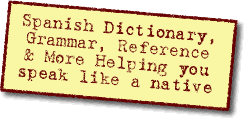Ask a Question(Create a thread) |
|
|||||||
The rolling r (and rr)This is the place for questions about conjugations, verb tenses, adverbs, adjectives, word order, syntax and other grammar questions for English or Spanish. |
 |
|
|
Thread Tools | Display Modes |
|
|
|
#1
|
||||
|
||||
|
The rolling r (and rr)
Yesterday I read in one of my Spanish grammars that the rolling r's and rr's are made by trilling your tongue on the back of the teeth (i.e. dental), for the r, once, and for the rr, two or three times. But normally are rolling r's and rr's said to be made by trilling your tongue on the alveolar ridge (thereof it's formal name, an alveolar trill). Now I am wondering which of them is the correct way of doing it, or if it differs from speaker to speaker, and dialect to dialect?
Speakers (also of the English language, and other languages as well) tend to pronounce L's differently as well, some hold their tongue on the back of the teeth - and others at the back of the alveolar ridge. There might be a difference with the pronunciation of r and rr, as in the example, as well. I know that some speakers of Finnish make their rolling r's from far back in the mouth, possibly as a velar- or uvular consonant, while others do it in other ways. So, again, it's possibly the r and rr are pronounced differently. I tried checking how I pronounce them, and I'm trilling on the alveolar ridge, and, even if I really try, I can't make my tongue trill on the back of my teeth. Some clarification would be good! ¡Gracias! 
__________________
¡Correcciones son muy bienvenidas! |
|
#2
|
||||
|
||||
|
In every dialect of Spanish that I've come in contact with, the trilling is done on the alveolar ridge (the bump right above your front teeth). I think that particular grammar book you have is not to be trusted.

__________________
If you find something wrong with my Spanish, please correct it! |
|
#3
|
||||
|
||||
|
Agree with David. You don't place your tongue on the back of your teeth, but on the alveolar ridge instead.
|
|
#4
|
||||
|
||||
|
¡Una rápida y buena respuesta como siempre!
I guess you're right, but I think I will continue using the book though. Hopefully it doesn't have other factual errors.  Edit: Thanks to you too, Rusty, for a second clarification.
__________________
¡Correcciones son muy bienvenidas! |
|
#5
|
||||
|
||||
|
Using a few different grammar books instead of only one might be a good idea.
I also dug up an old post I made concerning the pronunciation of the "RR".
__________________
If you find something wrong with my Spanish, please correct it! |
|
#6
|
||||
|
||||
|
I was going to correct the first adjective, but you caught it. Good job with your Spanish!
Rely on native speakers (through movies, songs, etc.) for pronunciation. Let's hope the book doesn't steer you wrong in other ways. |
|
#7
|
||||
|
||||
|
Quote:
And thank you for the link! (A quick off-topic question: how to do translate "to you too," as in "thanks to you too"?)
__________________
¡Correcciones son muy bienvenidas! |
|
#8
|
||||
|
||||
|
Quote:
__________________
If you find something wrong with my Spanish, please correct it! |
|
#9
|
||||
|
||||
|
Quote:
 Quote:
__________________
¡Correcciones son muy bienvenidas! |
|
#10
|
||||
|
||||
|
Quote:
 Quite right. Hearing how something is pronounced doesn't necessarily teach you how it is pronounced. I'm only suggesting that you mimic, as best you can, what you're hearing from a native speaker. The very best way to learn how something is pronounced is to ask for help, as you have done.  You figured out on your own that the book wasn't teaching you the correct method. That's because you're listening to the result. |
 |
| Tags |
| pronunciation, rr |
«
Previous Thread
|
Next Thread
»
| Link to this thread | |
|
|
|||||||
All times are GMT -6. The time now is 09:39 AM.










 Hybrid Mode
Hybrid Mode
